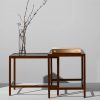Buying vintage audio or used high-end audio from the 1980s or 1990s can be a rewarding experience if you know what to look for and if you’re realistic about what you are taking on in regard to reliability, availability of parts, and the possibility of losing money if you decide to flip the equipment if things don’t work out.
Nostalgia is a nice sentiment, but it should not be the driving force behind your desire for just any piece of equipment. Performance, reliability, and the ability to get it fixed if something breaks has to be paramount to any buying decision.
Can vintage audio or used components that are 20-30 years old deliver a fantastic listening experience?
Yes, but that level of performance will come with a decent price tag. Don’t expect to spend $500 and get a Porsche.
You’re not getting a McIntosh tube amplifier or pair of restored MartinLogan CLS IIz for $500.
It’s not happening.
MartinLogan co-founder, Gayle Sanders, joined me on the Ecoustics podcast and we discussed this very topic and the history of these amazing loudspeakers.

When I visited the McIntosh factory in Binghamton a few months ago, Charlie Randall took me on a tour and we discussed the demand for vintage McIntosh equipment and how the company still has full time employees who only handle restoration and repairs of older equipment; the backlog is significant and some customers drive their vintage components across the country to hand deliver it.

A funny thing happened since we started covering vintage audio — our traffic went through the roof. Two of our regular weekly vintage audio columns have been read more than 220,000 times so far in less than 12 months.
Our review of the Cambridge Audio DacMagic 200M has been read more than 24,000 times to give you some context.
Not everyone in the industry is so happy about our approach because they feel we are diverting attention away from all of the new components by publishing 8 vintage audio features each month. 8 out of the 80+ articles we are publishing each month.
Let’s go for 10. I think 10 vintage audio features would be fun. Is it the wrong time to mention the 6-part vintage audio podcast series we have planned for 2022?
Never give me a reason to upset the establishment. It’s been a long 24 months.
But what about digital audio?
Digital audio has improved significantly from the days of “Perfect Sound Forever” and it’s relatively easy in 2020 to put together a streamer/DAC combination that will sound superior to a number of the pricier options that existed 20 years ago.
That being said, there were some excellent CD players from brands like Micromega, YBA, Mark Levinson, Spectral, Krell, and California Audio Labs that pushed the envelope at the time. The biggest issue will be the age of the moving parts, laser assembly, and overall condition of the unit.
There are a lot of great sounding vintage audio components (in good working condition) from brands like MartinLogan, Audio Research, Marantz, Mark Levinson, Naim, Yamaha, Thorens, Sansui, Nakamichi, Conrad-Johnson, Threshold, Aragon, California Audio Labs, B&W, and others available for sale but you need to educate yourself on the product before taking a financial leap.
Is the company still in business?
Can you speak to someone who can advise you in regard to specific models, parts, and the availability of instruction manuals? They may even have service records for a specific piece of equipment.
There is this desire when you find that “special” piece that you’ve coveted for years to jump on it; out of fear that another audiophile will snatch it up leaving you to cry over what could have been.
Do your homework before you buy. There are dealers who specialize in vintage/used audio and they can steer you in the right direction and provide some guidance on whether a component is worth acquiring. These same people might also have expertise in providing restorations or simple repairs.
Back to the Future
Back in the 1990s, I assembled what was a great sounding system with some of the components below. They would all be considered vintage in 2022 and I’m going to spend some time trying to assemble a vintage system for use in a spare bedroom that has the right acoustics for the loudspeakers. I don’t need a huge room for this system; just some luck finding all of these excellent components in the proper shape.
Selecting a power amplifier, pre-amplifier, and CD player/DAC will be slightly more challenging as the components I used back then (OCM, Copland, and Sonic Frontiers) have been discontinued for almost twenty years and aside from Copland, I have little faith in anything I might find the other brands at this point.
Bryston, Aragon, and Audible Illusions are already on my hit list.
The loudspeakers could work with a vintage Conrad-Johnson or McIntosh tube amplifier but that would push the cost up significantly.
I plan on keeping readers informed of my progress and we’ll see how it stacks up against my current systems at home.
MartinLogan Aerius i

Before Kansas-based MartinLogan was gobbled up and became a subsidiary of Paradigm loudspeakers, it represented a new vanguard in American loudspeaker design. The rebirth of the electrostatic loudspeaker with a twist featured the integration of a dynamic cone driver to add the lower octaves to an otherwise bass shy loudspeaker. MartinLogan’s esoteric CLS electrostatic loudspeaker looked great on magazine covers and delivered on its sonic promise, but it was also very difficult to drive and dominated any room where it resided.
The taller and slimmer Aerius i offered the transparency, detail, and speed of an electrostatic panel, but also the punch required to enjoy rock, electronica, and other genres of music.
Finding a used pair in reasonable condition has become easier in recent years, and It does make sense to have the factory install a new pair of panels to give your investment some longevity. The Aerius i were my third pair of MartinLogan loudspeakers (Sequel IIs, Aerius) and my favorite in smaller rooms. The Aerius i were not the easiest loudspeaker to drive; I switched back and forth between a pair of OCM 200 mono blocks and a single Aragon 4004 MKII power amplifier.
Learn more at: martinlogan.com/en/product/aeriusi
Thorens TD-125 MK II

The Thorens flagship belt-driven turntable was introduced in 1968 (the MK II in 1972) and it represented both an aesthetic and technical shift for the Swiss manufacturer known for its massive idler drive turntables. Belt-driven turntables with a sub-chassis were less expensive to manufacture and service and the design allowed Thorens to isolate the motor and sub-chassis from the turntable’s plinth resulting in better sound quality; the downside is that it needs a sturdier rack.
Thorens turntables work with a multitude of tonearms, including Rega, SME, Grace, Ortofon, and Jelco. Jelco ceased production in 2020 which is a shame as the arms work very well on the Thorens tables.
Turntable restoration companies like Vinyl Nirvana have offered beautiful restored versions for years but have seen the market for the older tables change dramatically in recent years; vinyl’s resurgence has made them scarcer and more expensive.
Learn more at: thorens.com
Magnum Dynalab FT-101A FM Tuner

People still listen to FM radio?
One of my greatest joys as a kid was listening to the radio. My father was a fixture on talk radio in Canada for a few decades and I spent more than a decade working at some of the largest stations in Toronto as a show runner and producer. Hundreds of millions of people listen to the radio every single day through their phones and network streamers and I love the ability to fall asleep listening to the BBC or stations in Israel; access to news and music from other countries makes it a very valuable service.
Depending on where you live, there are also still some excellent FM stations with strong signals broadcasting great jazz, classical, and alternative programming. It’s certainly harder to find unless you have a good antenna and few obstructions. We live close to the beach in New Jersey and I’m able to see parts of Staten Island and Brooklyn in the distance; there are also a number of college radio stations in NJ that I can pick-up with my antenna.
Magnum Dynalab has been manufacturing some of the best FM tuners in the world for a few decades and the FT-101A occupied a spot on my equipment rack for almost 10 years. I deeply regret selling it.
I had an unobstructed view of the CN Tower less than 5 miles from downtown and 4-5 of the best sounding FM stations in N. America. The FT-101A had the ability to make a good station come alive and with a rich and colorful midrange. Horns didn’t sound compressed or strident if your loudspeakers were decent. Magnum Dynalab is still in business manufacturing tuners, receivers, and streamers – and they still have parts to update discontinued products like the FT-101A.
Learn more: magnumdynalab.com
Related Reading:
Best Affordable Phono Cartridges to Elevate the Sound of Your Records
Bang & Olufsen Restores Classic Beogram 4000 Turntable for $11,000







































Joe
January 7, 2022 at 6:11 pm
“Nostalgia is a nice sentiment, but it should not be the driving force behind your desire for just any piece of equipment. Performance, reliability, and the ability to get it fixed if something breaks has to be paramount to any buying decision.”
So very true. Nostalgia is what has me interested in vintage audio gear, but when it comes to performance, reliability and being able to have it repaired, it’s getting hard for me to justify the cost. I decided a couple of years ago to keep my 1987 Yamaha Receiver (which I purchased new in 87) because of nostalgia. That and I like the tone controls, and the variable loudness control. However, looking for some vintage speakers to purchase to go with it is where I’m running into a problem. There are some excellent choices for new budget speakers these days (Q Acoustics 3030i, Triangle Br03, maybe the new Acoustic Energy AE100²) that I am finding myself reluctant to take a chance on some vintage speakers. I keep checking, looking for a good deal, but it seems these days people slap the “vintage” description onto everything audio and ask for what I consider too much money. Just looking at your numbers for how many times your vintage audio columns have been read, shows how popular vintage audio has become. And of course with this popularity comes demand, and hence higher prices. I haven’t given up on the idea of vintage speakers, but it may not happen. I had a pair of DCM Time Window speakers in the 1980s to go along with my Yamaha and turntable. I’ve seen a couple over the last year for sale locally, but again I thought they were priced too high and my offer was rejected.